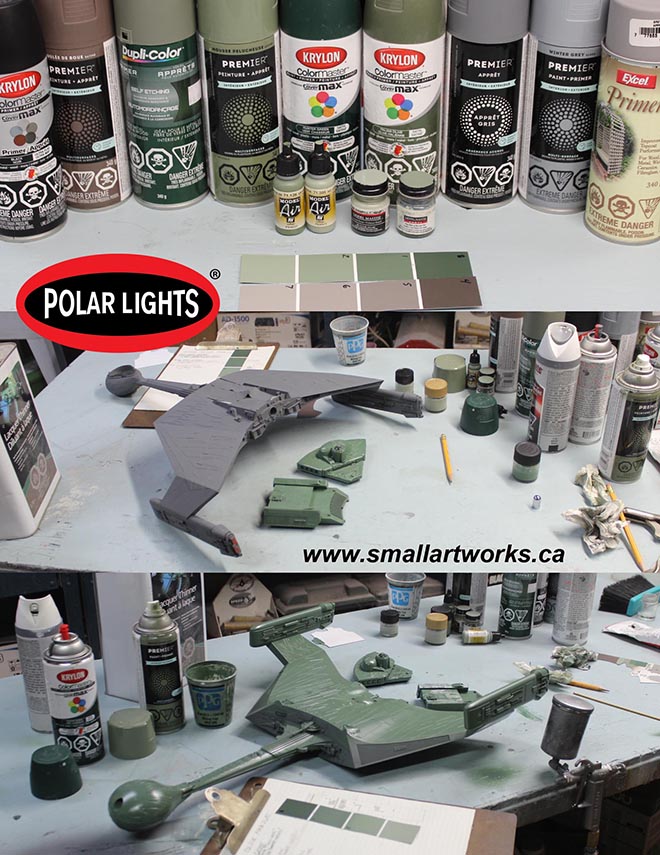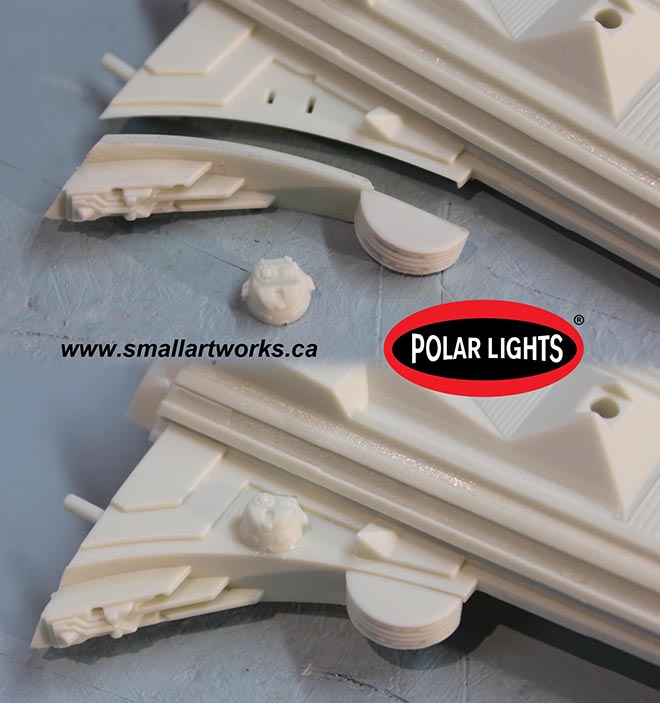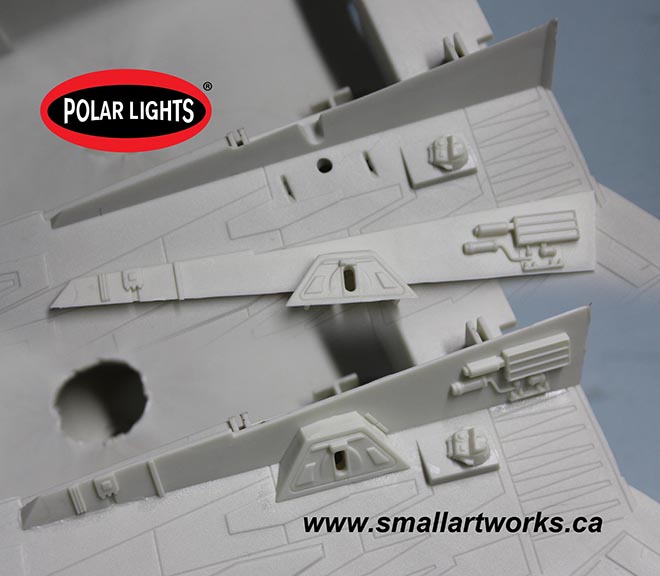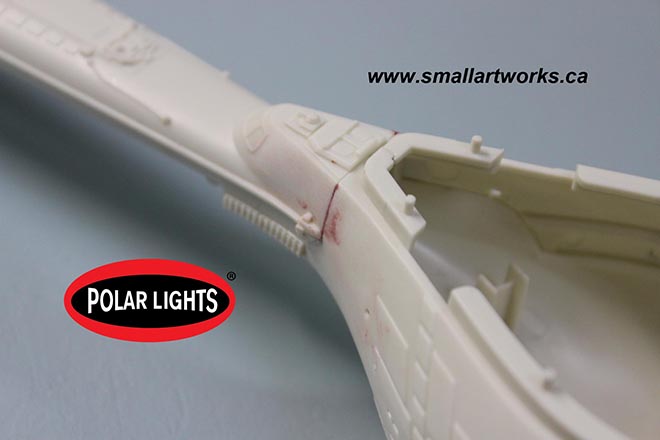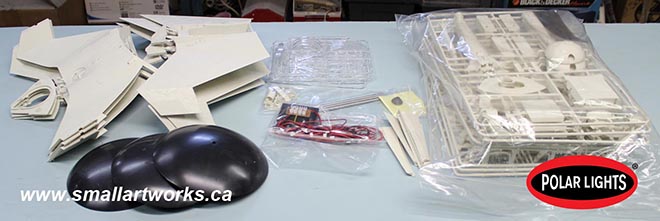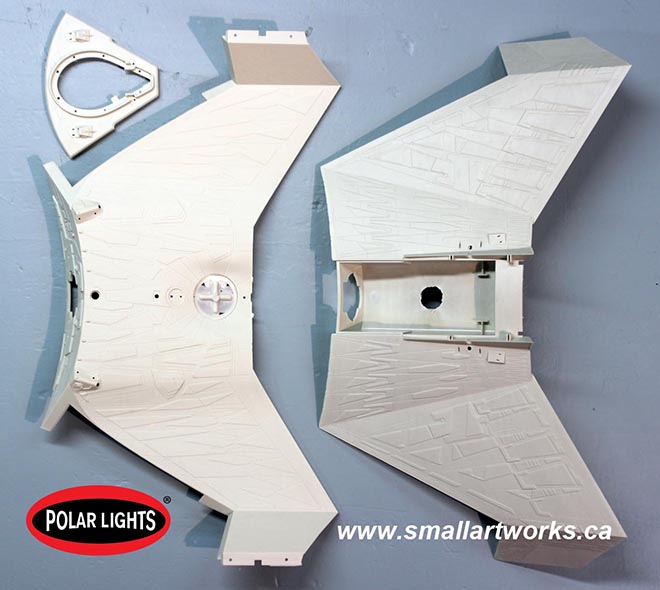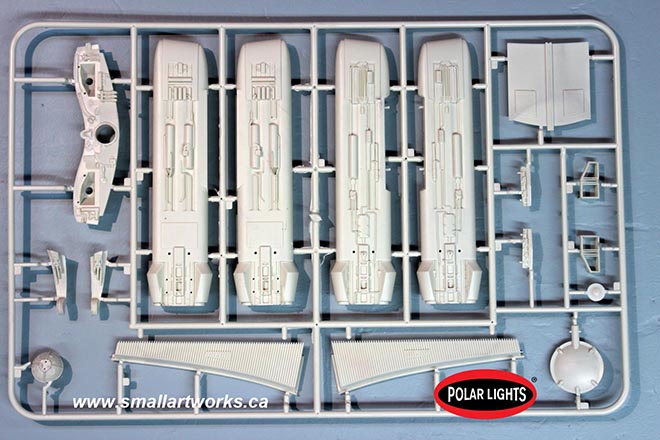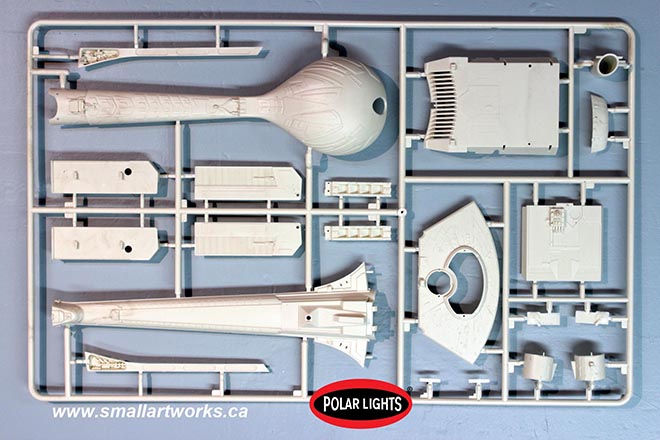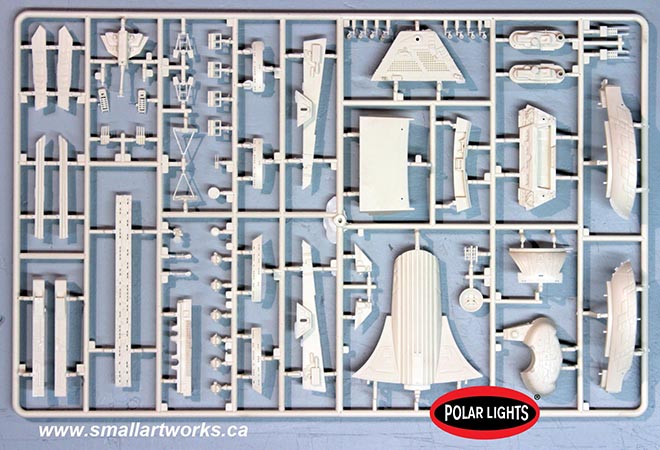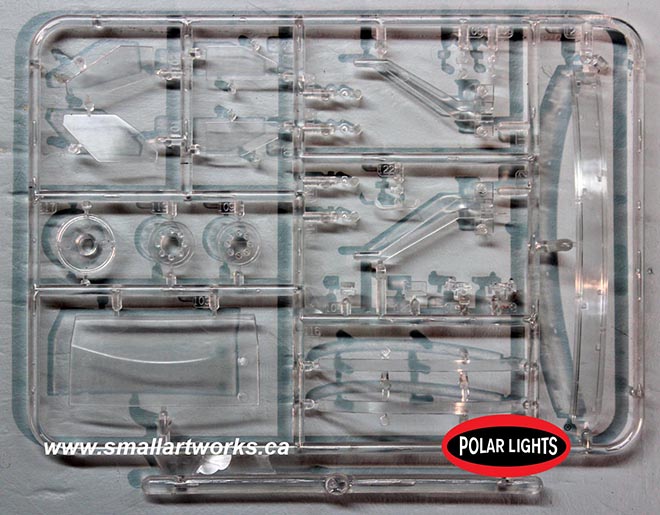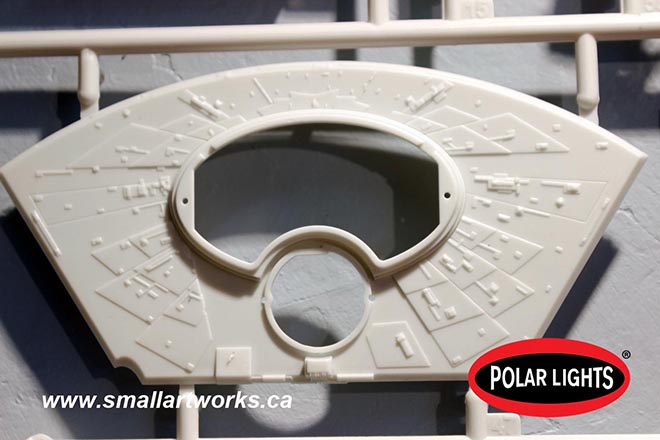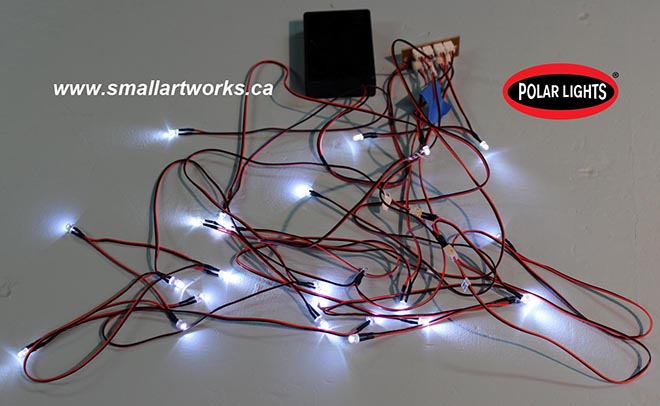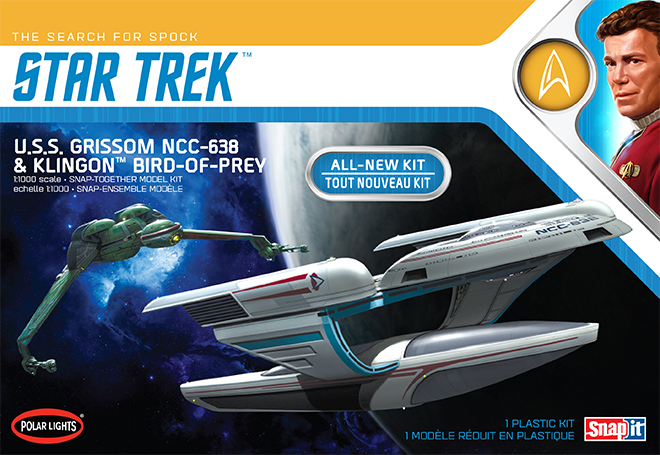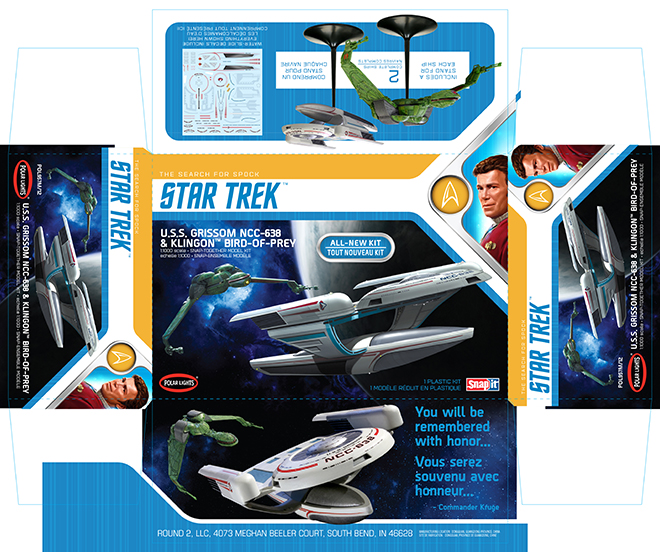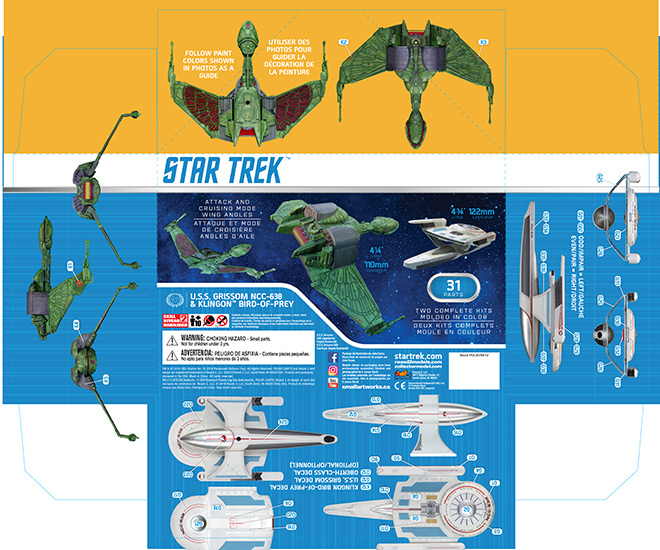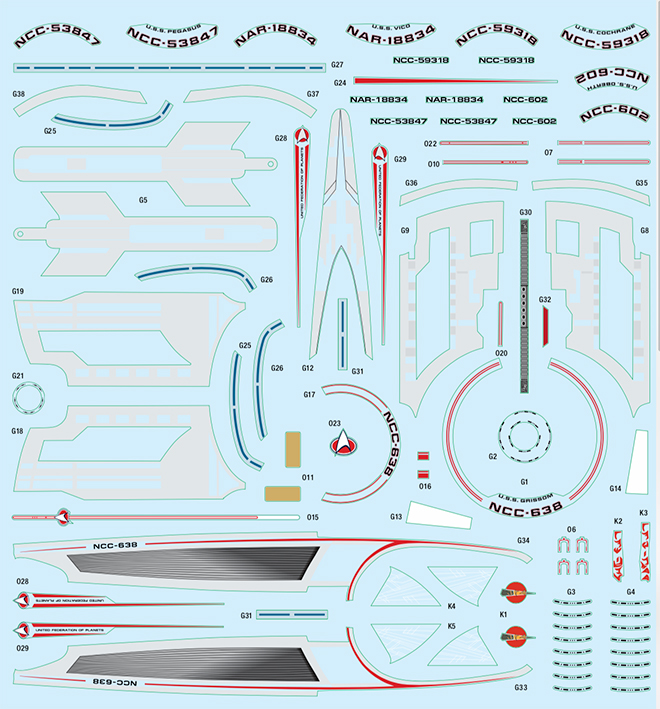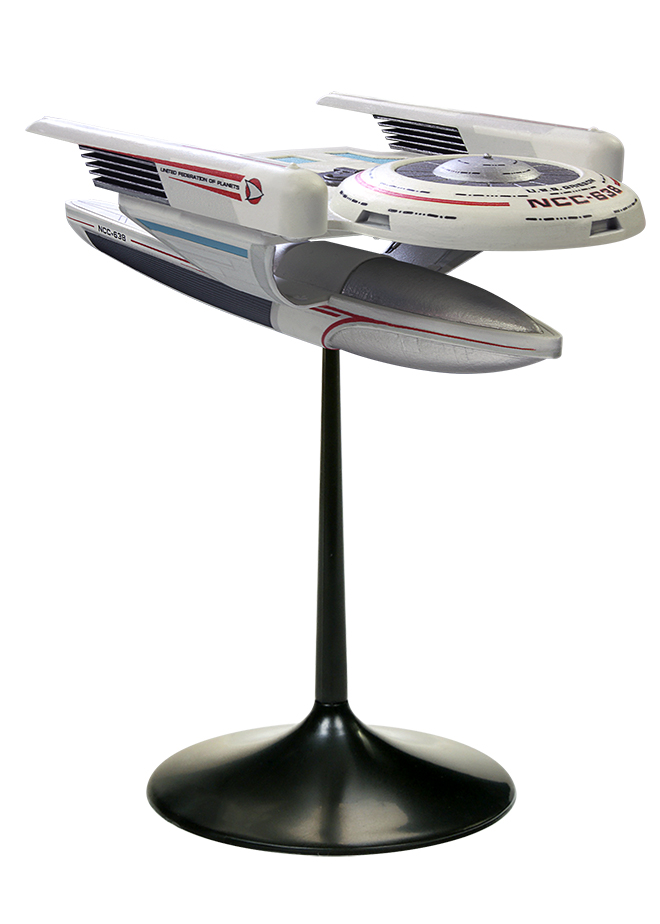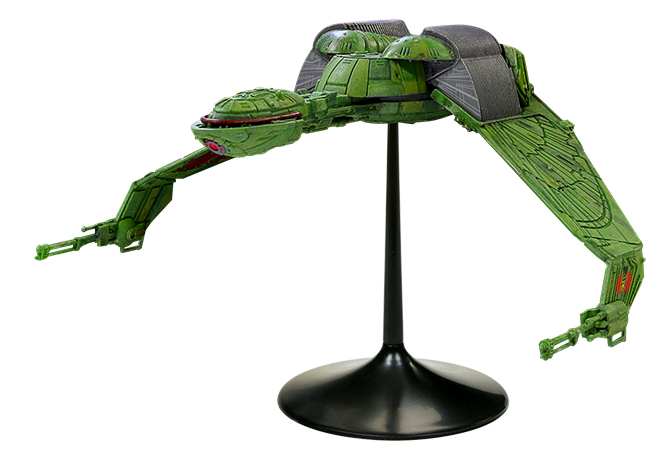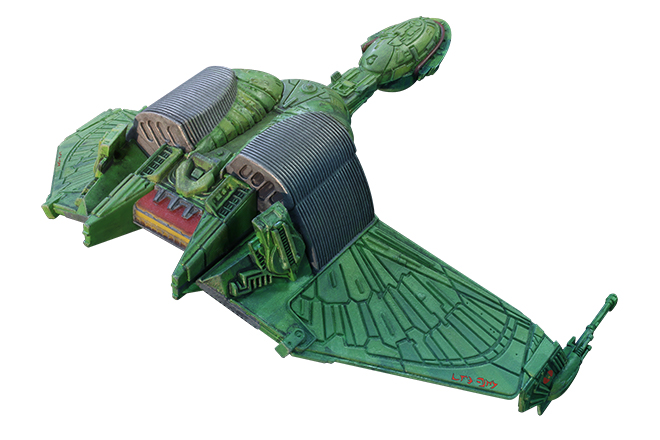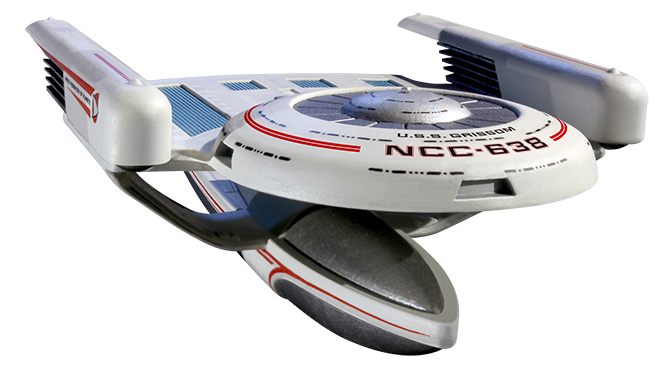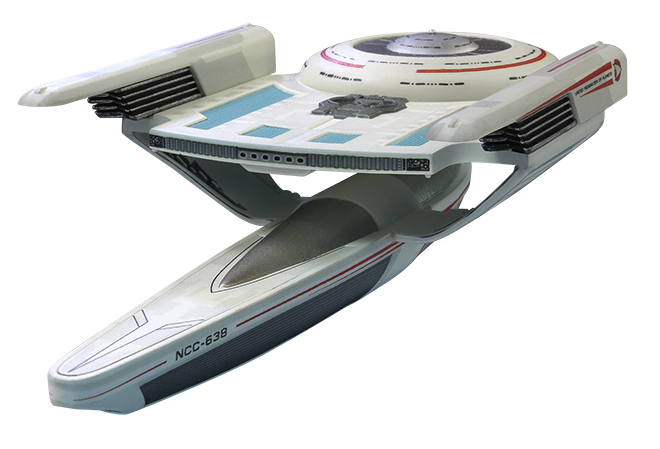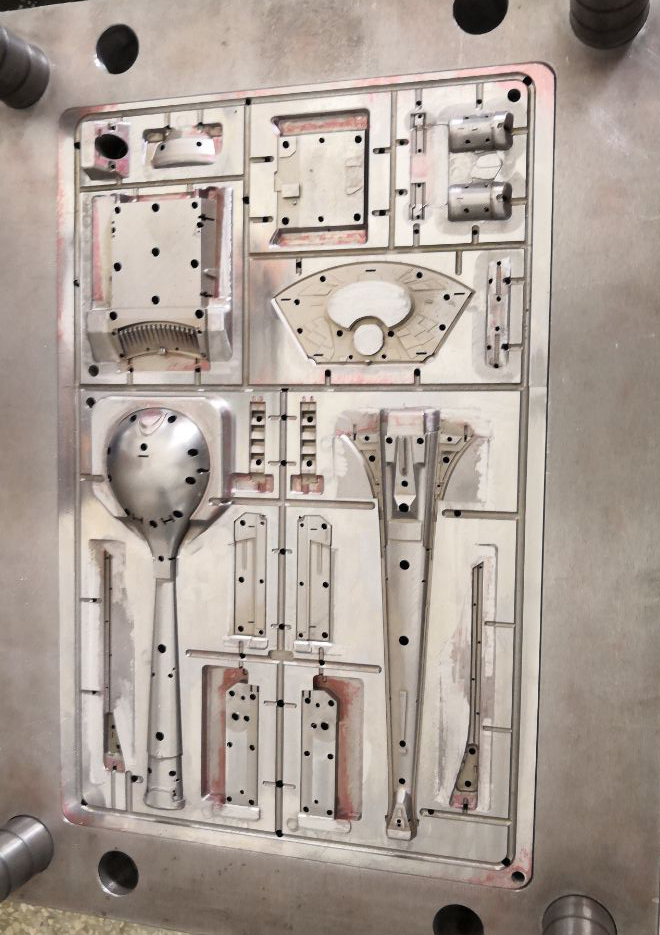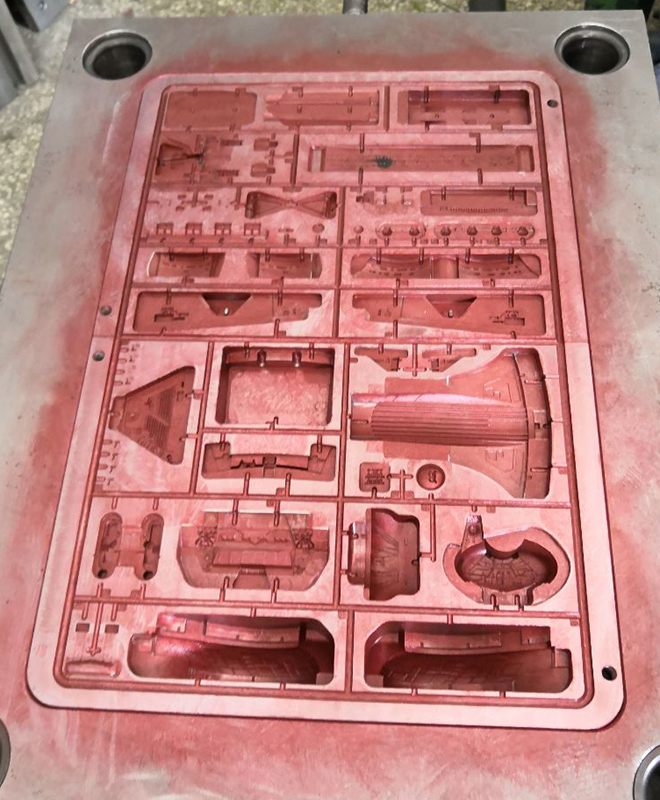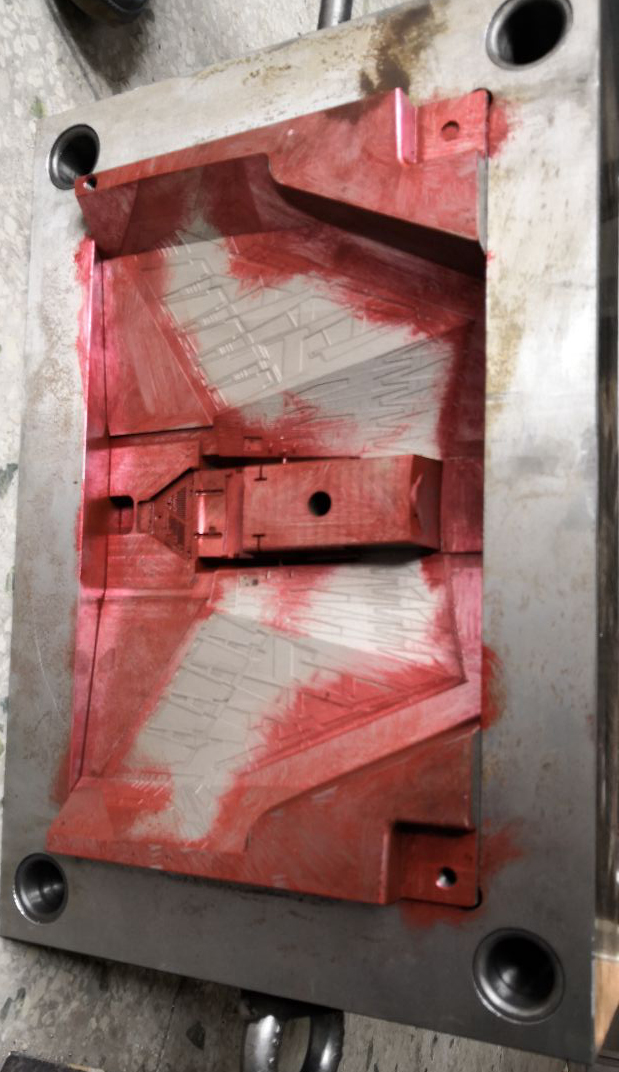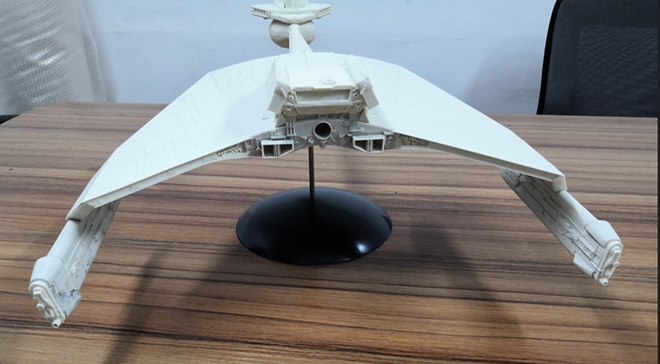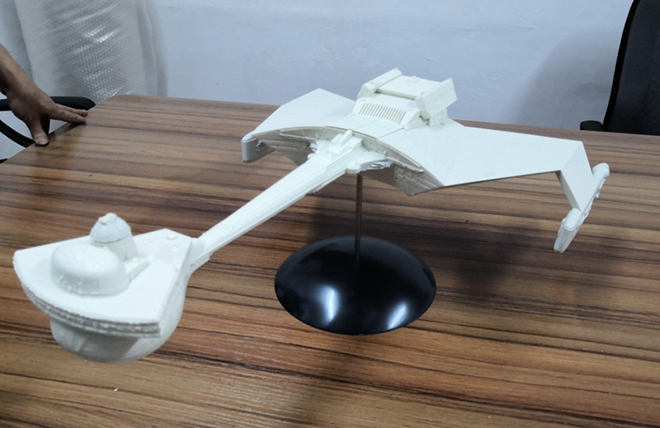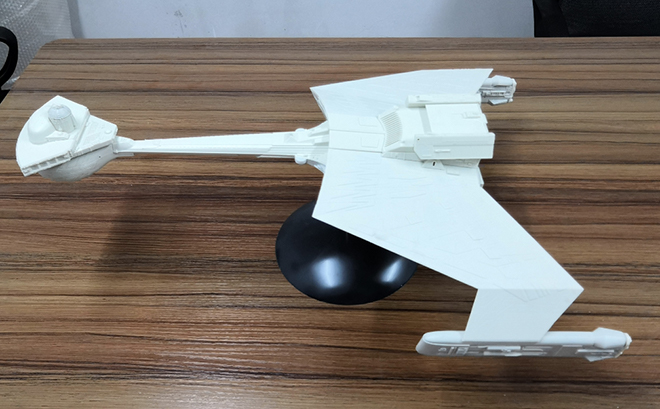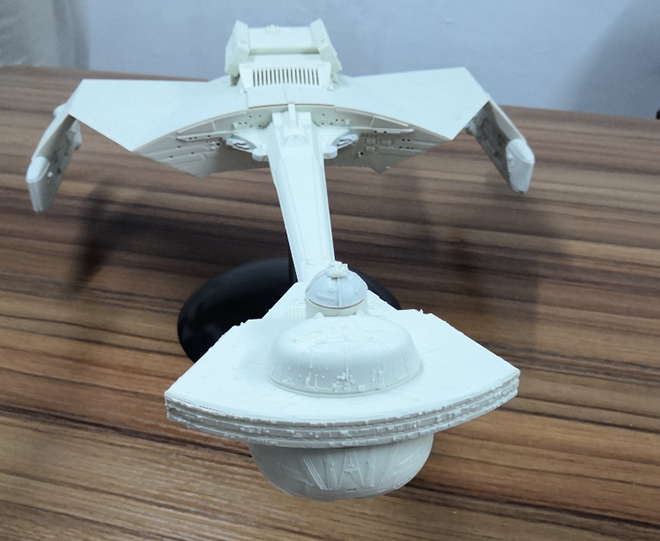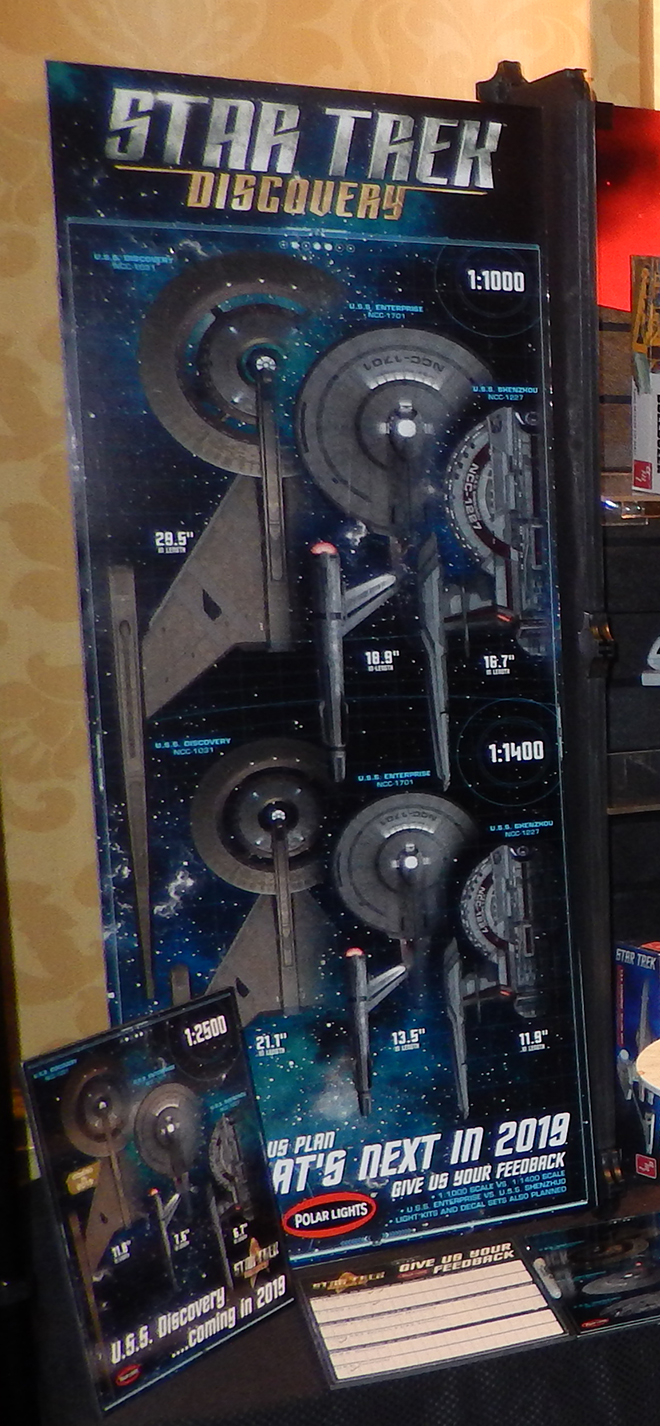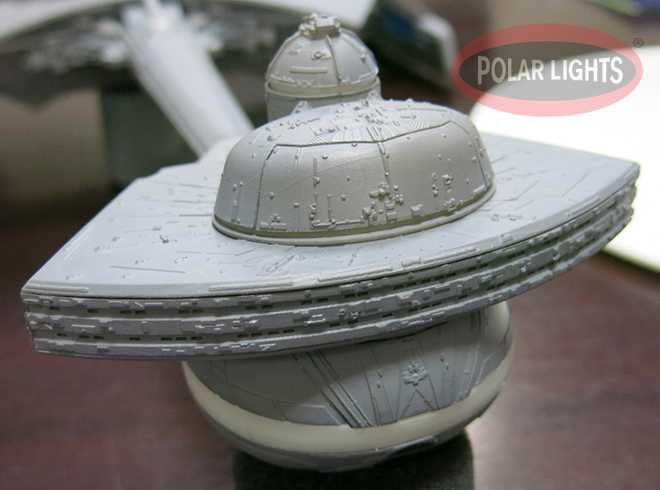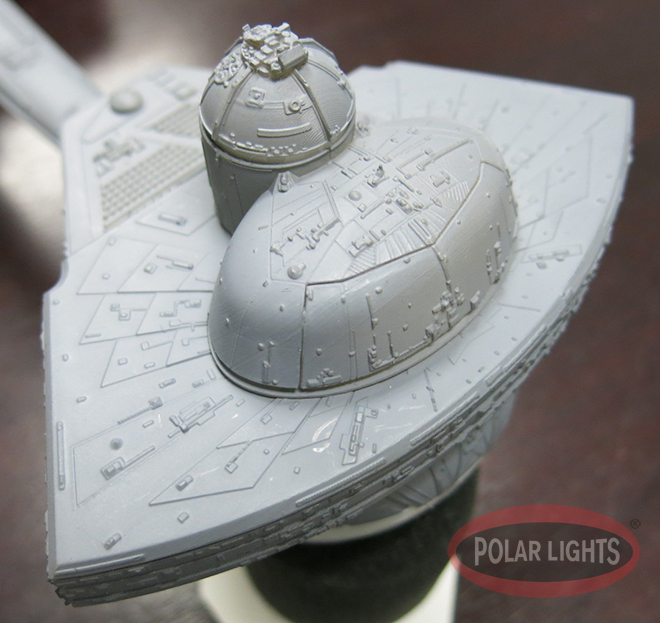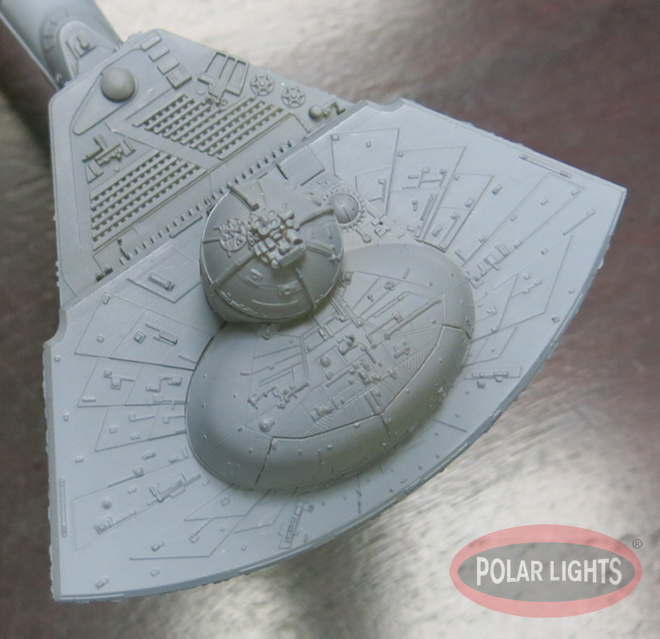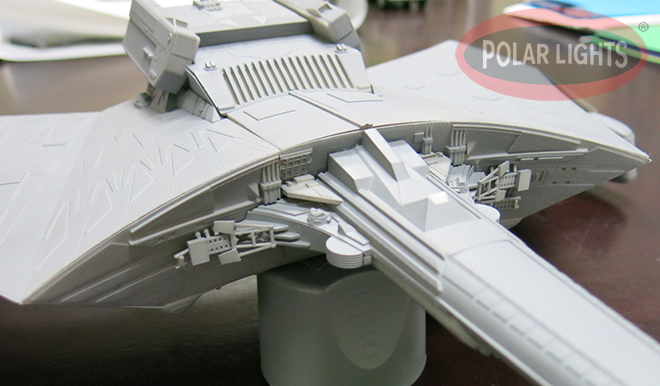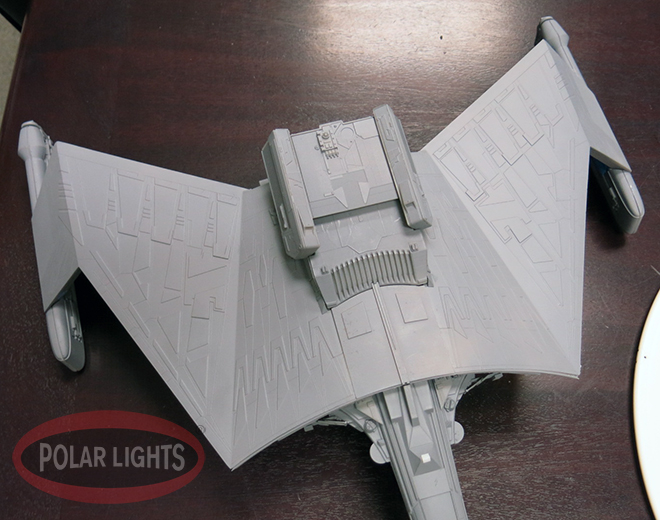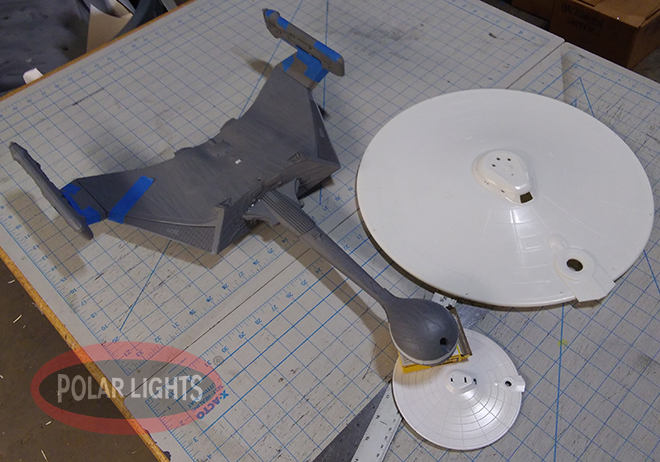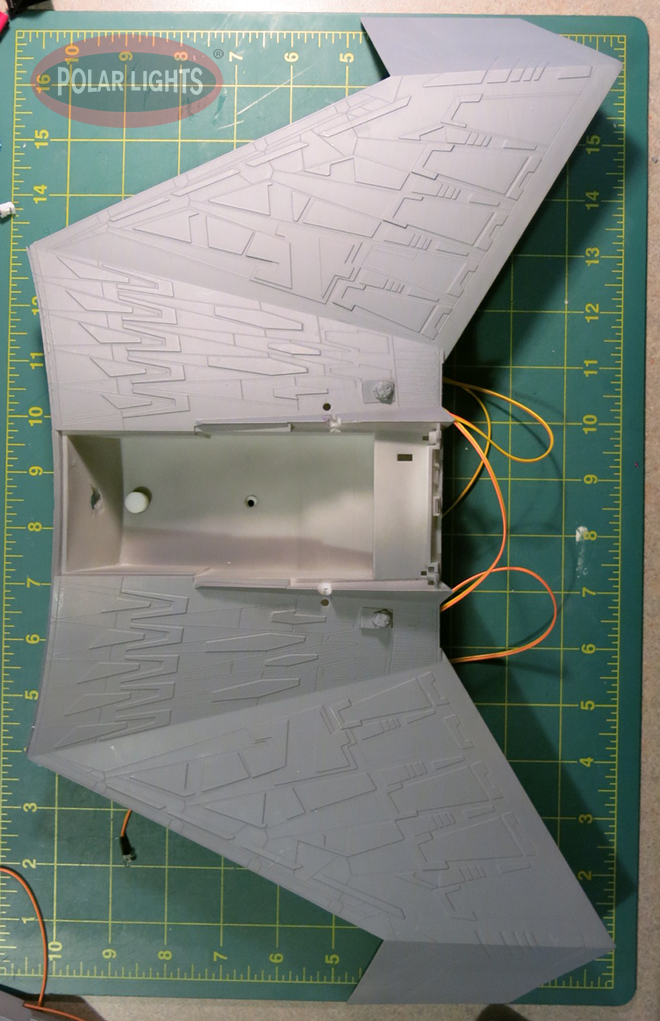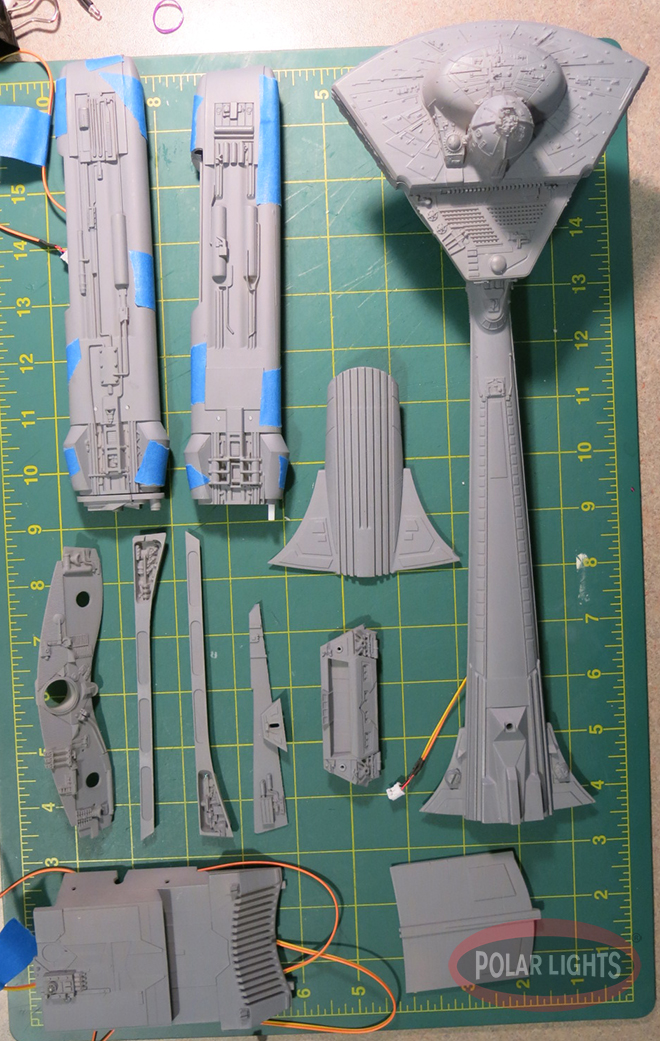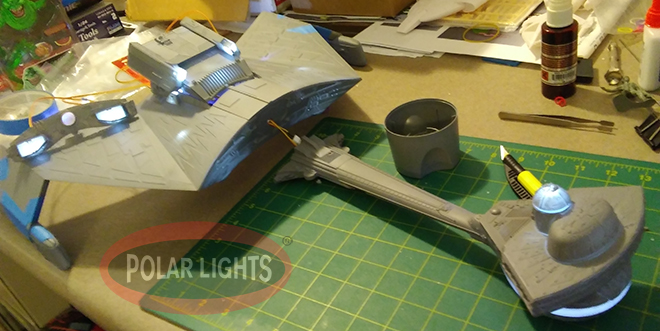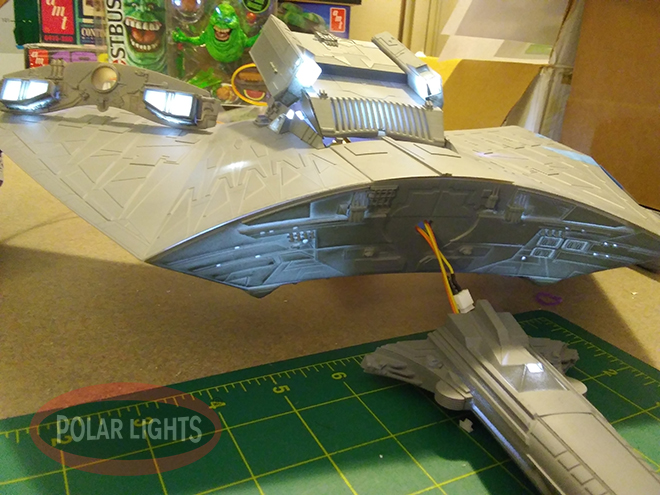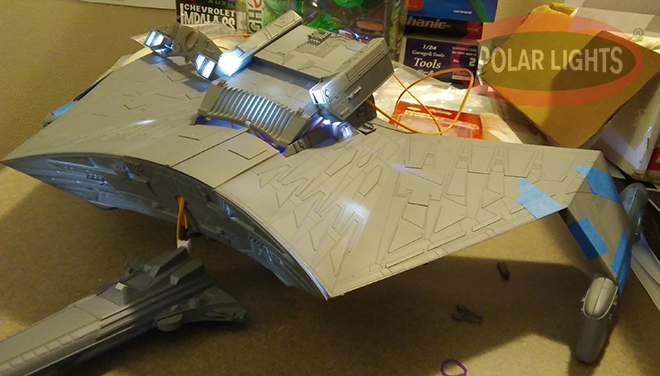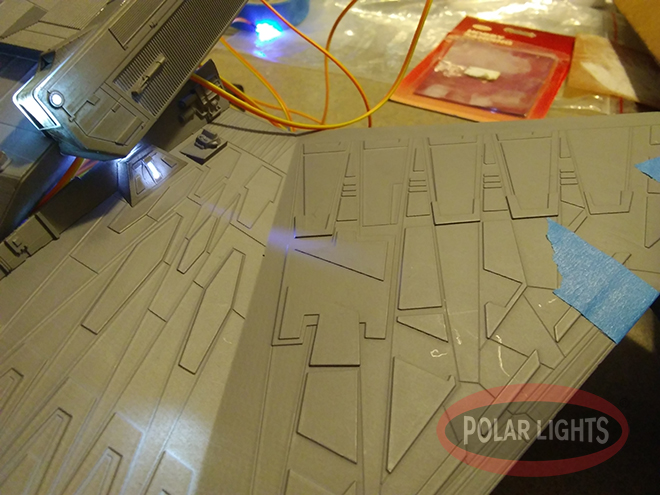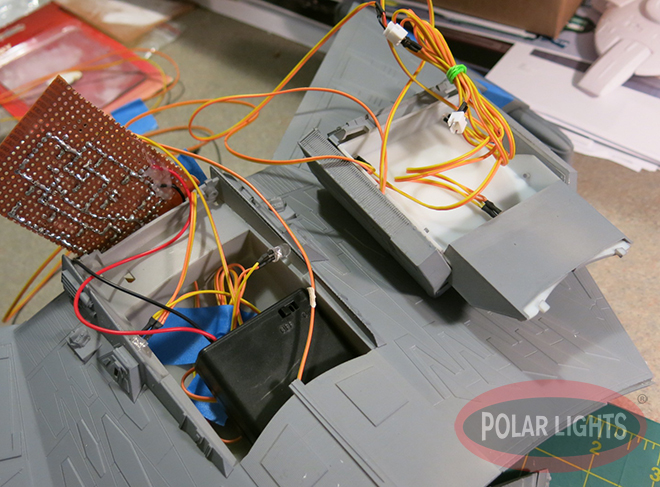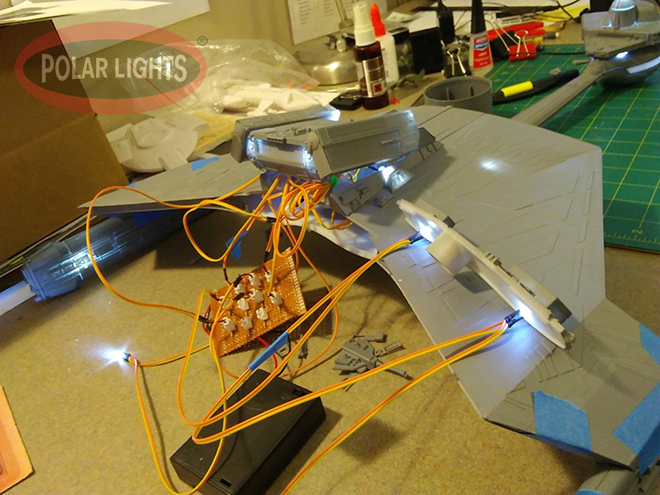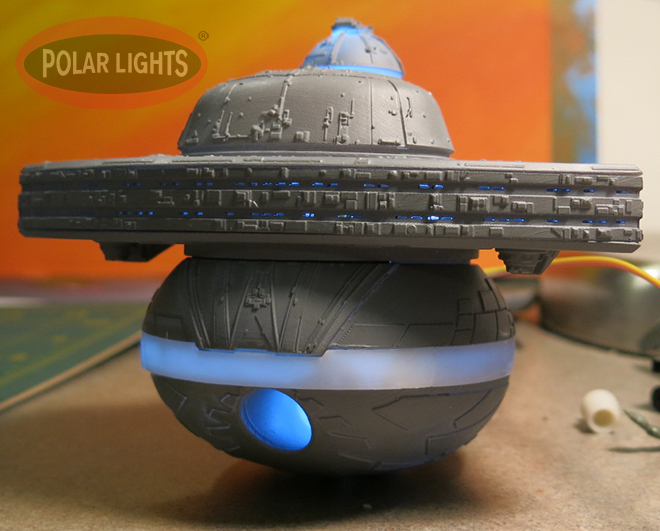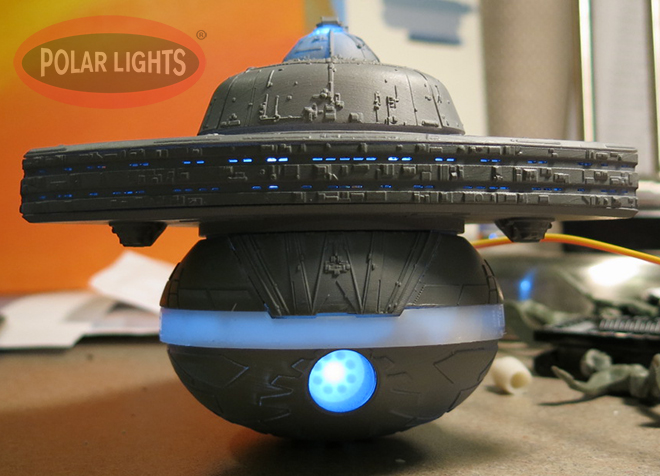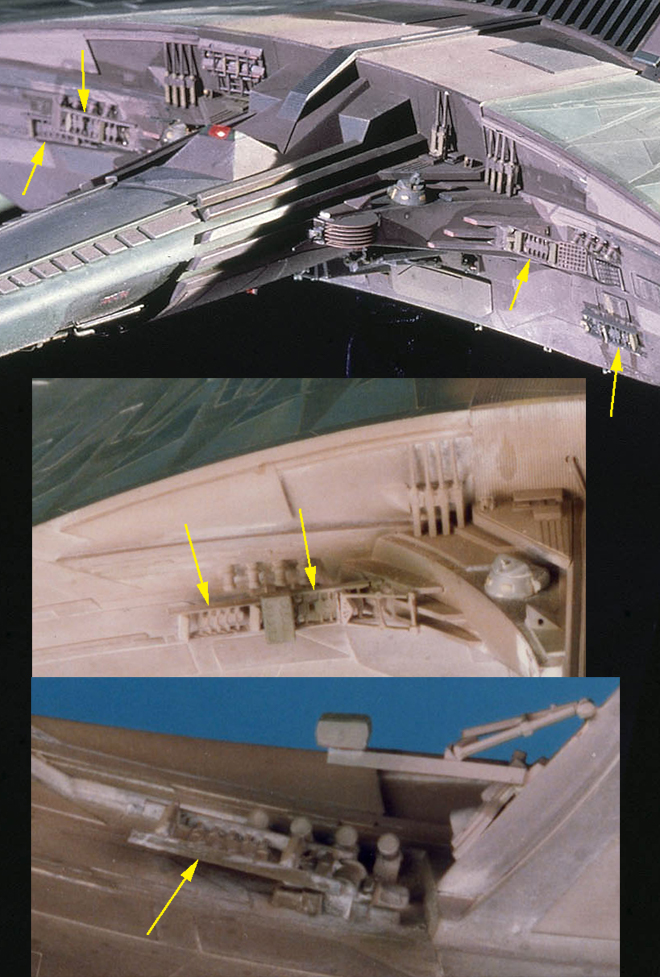

Archive for the ‘Round2 Models’ Category
Polar Lights Models: Klingon K’t’inga buildup process Pt.5
Continuing our series of guest blogs covering our brand-new STAR TREK: The Motion Picture 1:350 Klingon K’t’inga model kit…
K’tinga Build Part F’ORE!!! Watch it!
Painting is (VERY) Messy.
James Small, www.smallartworks.ca
Okay folks, this next bit is gonna be messy, especially to the rivet counters out there. That’s OK cuz I’m doing this for the box art and I’m still confused. Why? Because understanding colour is one of the most difficult things to figure out when building a replica model. Many blogs, posts, essays and maybe even books have been written that “prove” proper colours of various models. Some are right, some are wrong. When it comes right down to it, the only thing that matters is whether you like the finished model or not when you build and paint it using your own interpretation. In the case of the K’Tinga, a lot of interpretation is required because it is quite literally (and for you grammar Nazis out there… of which I’m one… the word literally is used correctly here) impossible at this point in history to prove exactly which colours were really used on the original filming miniature of the ship as you see on screen, because other than some rather limiting photos, no absolute record of the actual colours exist. For example, when you watch the movie, the colours don’t look anything like those that were actually applied to the model. Various lighting techniques, colour values on film and blue-screen photography combined with film duplication all have massive effects on what the models really look like between stage and theatre screen.
Jamie will (at some point) follow this with a write up of the extensive research he did to try to figure out the correct colours to paint the model. The model you will eventually see on the box art and publicity pix both here and on the SAW page will be the results of his heroic research based on extensive photographic colour correction and information supplied by some of the original model makers who worked on the VFX miniature.
However, you must remember that in the case of this model, the ultimate result is what YOU the builder thinks looks right in the end. I repeat myself when I say that since it is IMPOSSIBLE to know what the original colours were, everything is open to personal interpretation and preference.
OK? Got it? Then here we go. The photos may seem somewhat incoherent, but then, it’s messy, and the nature of the way I work doesn’t necessarily lend itself to structured photos. I’m afraid you’re just gonna have to deal with that.
I began by spraying the model (after strategic masking) with Krylon grey primer. This primer is dense enough to provide adequate light blocking but multiple applications were necessary in some areas. Nooks and crannies are more problematic to fill in. Then I mixed up some colours using the cans I have available. I am usually limited to what local hardware stores sell as the nearest hobby shops are a few hours’ drive away and I’ll be damned if I spend $45 on gas to buy a $10 per tiny jar of hobby paint that doesn’t necessarily match anyway. One of the things one must accomplish with model making when you live in rural areas is to play with the cards you’re dealt, you know? Spray cans cost a fortune up here but they are still the lowest cost alternative. I’m showing you in the picture some of the colours that I am using, but that’s not written in stone either. Jamie will provide information on more universally understood colour selections.
Here’s a hint: Mask all areas you want light to shine through (obviously) and then spray the model overall with the grey primer. Then when done, hook up the lights and turn them on (in total darkness) to find light leaks. Then, put primer into your airbrush and spray it into the light leaking areas when you have the model’s lights on and can see the light leaks in the dark. In other words, you will be painting in pitch black. That’s the best way to find and seal up light leaks.
After the light leaks were sealed, I mixed up some paint and sprayed the overall hull colour the darkest of the three greens that Jamie figured out which is the overall colour of the ship. Was this a mistake or the right way to do it? Well, just like you, I’ll find that out in the next installment of….
“Painting, The Klingon Way”
Yeah, sorry. I’m sure there were a lot better ending lines to finish this post but I just didn’t have the time to think of something clever. I’m tired. I need to sleep now. The paint needs to dry anyway.
Polar Lights Models: Klingon K’t’inga buildup process Pt.3
Continuing our series of guest blogs covering our brand-new STAR TREK: The Motion Picture 1:350 Klingon K’t’inga model kit…
The K’tinga Build Part Deux, A Mounting Problem
James Small, www.smallartworks.ca
As I’m building three of these at once, I made the decision to modify one model to make it easier to photograph for the box art and publicity images. Therefore, this particular post deals primarily with the modifications I have done to this model to put stand mounts (AKA an armature) inside the model so that it can be positioned for photography at various angles, similar in principle to the way Motion Control miniatures were made for bluescreen filming back in the day.
The first thing was to decide where the mounts needed to be. One obvious mount is the stand hole that is included in the kit so it can be bottom mounted. That part is not needed to change of course, and Round 2 thoughtfully provided a plug/hatch that covers up this hole for underside shots and for people who may not want to use the provided stand. Another mount already built into the kit is also a natural, the torpedo tube on the rear. The inner tube is a bit short, and must still contain the lighting inside, but I can make a post to fit for the purposes I need. The way the kit is designed, this torpedo tube will be strong enough to support the model when mounted from the rear. However, I needed to make the model mountable from the sides and the top. Because of the ship’s design it’s impractical to make a mount for the front. For shots involving the rear of the ship facing camera, it can be mounted from the sides, top or bottom depending on the angle needed. It seems, based on photos of the original model on stage, that these were the mounts used on it as well.
The stand hole molded into the lower hull section is deliberately quite deep and intrudes into the battery tub which is molded into the upper hull section (top), and I wanted to keep the upper hull removable until the model was at a near complete stage so lighting could still be installed. So I had to carve away some of the plastic so the square tubing I’d use for the armature would fit over it (bottom right) for support and without gluing. I drilled a hole in the top of that mount so that the hatch plug, which covers the stand hole when bottom shooting is required, could be pushed out from the backside when its removal is needed.
The armature, entirely glued into the upper hull battery tub section was made from Evergreen styrene square tube to fit the stand mount square stock (rather than cylindrical tube) so that the model would not have a tendency to rotate during set-up for shooting. Visual effects miniatures usually use much more robust armatures machined from aluminum or similar because the fairly large and heavy models must be kept rock steady during motion control filming, but this kit is so light that plastic armatures are good enough for my still-shot photographic purposes. You can’t really see them in the photos here but extra web reinforcement was also glued to the back of the square tube mating with the battery tub for added strength. Sections of the tub were also cut away to aid in wiring for the lighting as well as access to other sections during construction and/or possible servicing. The side armature had to be kept short so that it would not block the lighting for the forward bulkhead up front. The light will be blocked when the stand mount is plugged in but that won’t matter since I won’t use the side mounts when that section of the ship shows to camera. The top corrugated panel on the forward section of the main body was made separate in the kit, which is perfect to aid in painting and also act as a natural hatch for the top mounting point. A pair of glued on neodymium magnets hold it perfectly in place.
The problem with the side mounts is that, even though the grilles on the sides look big, they are at a very steep angle (about 60 degrees) so the side profile makes them very narrow. This had to be taken into account when planning the mounting rods and armature. But the problem was that the grilles on the kit were made to be cemented in from the backsides of the body before you attach the top. How to make the panels removable, yet easily replaceable when the model is finished? The answer can be seen here. First, the grille panels were modified so that they could be placed from the outside. Then a magnet was added to the inner surface. Why is there a screw? Because when you’re dealing with this kind of thing with all those crazy angles and no apparent mounting surface, you can’t be absolutely sure where things are going to fall. By putting a screw (which the hatch magnet will stick to) into a solid point deliberately set further back than you might anticipate, adjustments can be made if things don’t line up quite right.
Here you can see the grille hatch unmodified and modified with trapping sections cut away and a magnet added. Then you can see the result of what the finished model will look like with the grille hatch removed and attached. They work fairly well. How do you remove the hatches? Because the screw is roughly in the centre of the hatch and acts as a crude fulcrum, you just push on one end, the other end pops proud and you can just grab it to pull it free. Another advantage in making those grilles removable is that I can complete some of the wiring even after the top and bottom body sections have been glued together. I still have the likely problem of light leaks around the removable grilles. I’ll work on that next along with a bunch of other things. More stuff to think through.
Looks easy doesn’t it? But with many things, it takes a lot of thinking to come up with the simple solutions to what look like complex problems. There are so many crazy angles to think of here that it seems very daunting at first, and you have to think ahead and carefully examine everything. Will it impede lighting? Will it stop the assembly from going together right? Will it allow for stand clearance? It takes time to work all that stuff out and you don’t want to make a modification that won’t work and become impossible to reverse. In fact I’d say ~90% of my time in building this model’s various modifications so far was spent thinking about how to do it and if there were better alternatives. In some cases maybe there are and I just didn’t think of them. The actual work itself takes relatively little time once you come up with the idea.
Meanwhile, if you future K’Tinga builders out there have a desire to mount your model from different points other than the standard bottom mount, maybe what I’ve done here can give you some ideas of your own.
Enjoy!
Polar Lights Models: Klingon K’t’inga buildup process Pt.2
Continuing our series of guest blogs covering our brand-new STAR TREK: The Motion Picture 1:350 Klingon K’t’inga model kit…
The Ktinga Building, Part One
James Small, www.smallartworks.ca
Oh, OK, I won’t bother with the double entendres and food jokes with this one. Just the straight up dope this time, albeit not with a lot of pictures. Most of my time was spent just looking through the parts, test fitting and comparing them to the CG model (used for the tooling) and gaining an understanding of what goes where and when certain parts should be assembled and which ones should be left off until lighting and painting can be done. That’s the way it goes when you’re building a kit (actually three of them in this case) for the first time without the instructions that will be included in the final kit! I’m also doing what I can to document it for both this blog and for possible ways to make minor improvements in the kit as we go along so such changes can be incorporated into the kit as you people will be buying it. The test shots have been done, but small improvements will still be made, which is why they are called TEST shots. Also, I wanted to actually get PAST the points covered in this blog to make sure I covered it all needed before the next. Lotsa back-and-forth with this one.
First, I will let you know that I will be describing this build with the lighting kit being installed, as this is the most comprehensive way to do it. If you will NOT be installing the lighting (why would you NOT want to light it up???) then you can take obvious shortcuts, but I will not deal with those shortcuts here.
I wanted to assemble as much of the sub assemblies as I could before the lighting or painting needed to be applied. That part turned out to be a bit tricky as this is one of those models you need to do a little bit of each as you go along. That means there will be assemblies you will build, then you will install SOME lighting, then you will build some more, do a little painting, then put in more lighting, then more building, and back and forth and so on until it is finished.
The next thing I want to talk about is how to properly remove the parts from the runners. There are a lot of delicate corners and edges on this one, but if you are careful removing the runner gates, no putty will be needed to smooth things out or hide joints. The pic FIG 1 shows the procedure. First, cut the part from the runner while still leaving a good chunk of the gate attached to the part. Then, using your nippers or a sharp blade, slowly whittle off the remaining nub. Finish the surface off using a needle file. The better you do this on EVERY PART of the model, the better the parts will fit.
The first parts I assembled were the “Cobra Heads” of all three models. When the above parts preparation procedure is followed and you take your sweet time assembling, the parts fit together absolutely perfectly with no puttying needed and almost no cleanup except for a slight scraping of the edges with a sharp knife after the glue has set. The procedure used to properly glue these parts was covered in an article I did years ago for Round 2’s now defunct “Workbench” page, but can be viewed here on the Small Art Works hosted CNSM page for those of you who would like a refresher.
http://www.smallartworks.ca/CNSM/VS%20build/Pretty%20In%20Mauve.html
Note in FIG 2 that no putty was needed to successfully assemble the parts which are well engineered. I’ll let you in on a little secret here. Although some modelers demand such amenities (which is why Round 2 provides them), I deliberately did NOT use the clear window parts supplied with the kit that would normally be installed behind the outer hull window panels. I find that too difficult to work with (though some modelers have no problems with it). I instead will leave the windows unglazed, then after painting I’ll fill the window holes with Testors “Clear Parts Cement and Window Maker”. Microscale makes a similar product called “Micro Crystal Clear”. In a p[inch white glue would even work but white glue is not as transparent. Then, when the model is finished, a clear dullcoat spray will fog the windows enough to provide properly diffused lighting from the LED’s inside.
Because it called out to me, I quickly assembled the bridge cylinder and the elliptical section that sits on top of the cobra head because those were so easy to do. The elliptical section glues together so well that the gap is unnoticeable as it falls on a natural panel line. Then I glued the cylinder to the cobra head section and noticed a GAP! OH NO! Naw, false alarm. The gaps that you see in the pictures are actually supposed to be there. It’s likely a result of the original VFX miniature being made that way, because the bridge section was made removable for maintenance and so, yes, those gaps are authentic! So before everyone complains, that is NOT an error of the kit! See FIG 3. Very little clean up was needed between the two cylinder halves.
The next thing I assembled was the lower part of the head which I call the “bulb”… because… duh… that’s what it looks like. The best way to go about this (hey, I had three tries, eh?) is to cement the forward part of the top half of the bulb together with the two sides of it so that all three parts of the top half of the bulb are properly aligned. Do this while continually testing (but not gluing it) to the cobra head section that will eventually be permanently mated with it. Then, when the glue has set, cement the top to the bottom half and then glue the window sections in place as shown in FIG 4. The torpedo tube was also glued in at this time as well. Any slight overlap of the window section relative to the bulb section can be easily trimmed down or disguised by the fact that the entire window section will be painted black, so the parts seam line will be naturally disguised by that very obvious colour difference. This deficiency is being worked on by the factory to improve the fit. Also, a decal for the darks tripes that go over the windows will be provided. The bulb is NOT glued to the cobra head yet. That will be done after the model is painted and the lighting is installed.
Next I glued on some rather insignificant detail parts (FIGS 5 & 6) because there were bits that would need to blend into the finished model which did not need any special treatment and could be added without being detrimental to the lighting system that would later be installed or impede paint work.
The sharp eyed observer will notice the direct tie in to Star Wars on this model. Yes, the foot pad from the R2 D2 MPC model kit was actually used on the original filming miniature exactly as you see, tying Star Trek and Star wars together the way only ingenious model makers can! In this case, R2’s foot was used as the vehicle from which the Klingon insignia spotlight would shine. See FIG 6.
I did find just one spot that needed some putty between the joints, but it’s a very easy fix. See FIG 7
Quite a bit more has been done to the model since these photos were taken which will be covered in the next installment.
Polar Lights Models: Klingon K’t’inga buildup process Pt. 1
Just like Santa takes a vacation the day after Christmas, model kit brand manager Jamie Hood has dropped off the goods (in this case, that means K’t’inga test shots) and is off on vacation. In the meantime, Round 2 consultant and model builder Jim Small will be sharing the process of building our display model that will be featured on our box art and will be making appearances at shows like Wonderfest next year. We hope you are hungry for this series of blogs.
Three Delicious Servings of Styrene Goodness!
James Small, www.smallartworks.ca
Well, well, well!!!! Look at THIS!!! A wonderful plate of appetizers came to the carnivorous lair of Small Art Works today, filled to the top with three test shots of the next fantastic model kit release from Round 2 and Polar Lights! I’ll be building all three of these at once, assembly-line style for the most part. All will be lit, but one of them I plan to try and install mounting points on the sides, top bottom and rear of the ship the way the studio model was done, which will aid in the photography I’ll need to do for publicity photos and box art etc. Only one lighting kit was supplied by the factory so I’ll have to scratch the lighting for the other two. Several parts had come loose from the runners and were put into ziplock bags. Each of the three main large sprues shown measure over 17” x 11” in character, so that gives you a good idea of how big this model will be!
I’ve taken some pictures of all the sprues here so you can see for yourself the delectable ingredients supplied with the upcoming kit, the loose ones were put in place into the runner locations they came from to show you. The parts are very crisp and clean, panel lines are perfectly recessed to match the original and the fine seasoning of detail is very sharp! This kit is exactly half the size of the actual filming miniature as seen in Star Trek, the Motion Picture. Yes, this kit really IS as good as it looks to be and will make a satisfying full course meal for all avid Trek fans!
As I write this I have examined the parts overall and have tested the lighting system. Next I will be studying it all to figure out the best way to cook this thing and work out assembly and painting strategies. Likely I will be looking for the “quick” subassemblies to get out of the way first.
The biggest challenge of this kit will be the tasty paint work… the “icing on the cake” as it were, as there are many colours in this menu which will need a LOT of masking! Jamie will be supplying me with the paint colour information as he’s probably THE world authority on this model by now because he’s been preparing for this feast for quite a few years and has worked tirelessly to make it as complete and accurate as possible! He knows more about what goes into this dish than just about any other galaxy class chef at this point.
I’m going to really enjoy preparing these meals over the next while, and I’ll post my progress here as I go, so bookmark “collectormodel.com” and keep checking back! You may find some of what I bake here a helpful series of hints to supplement the main recipe that will satisfy your taste buds when you place your order!
Let’s get ready to dine with the Klingons! (Bring extra napkins, and yeah, I was hungry when I wrote all this.)
EjIMBo
See how crisp and clean the fine detailing is? Delicious!
Quick-and-dirty testing the lighting system. Looks like a mess here but it’ll be worked out. Two of the bulbs flash which is why one is off as it blinked during exposure. All lights work perfectly.
Higher resolution pics can be found at the Small Art Works Facebook page here.
Coming off the Shelf – Big Summer Mack
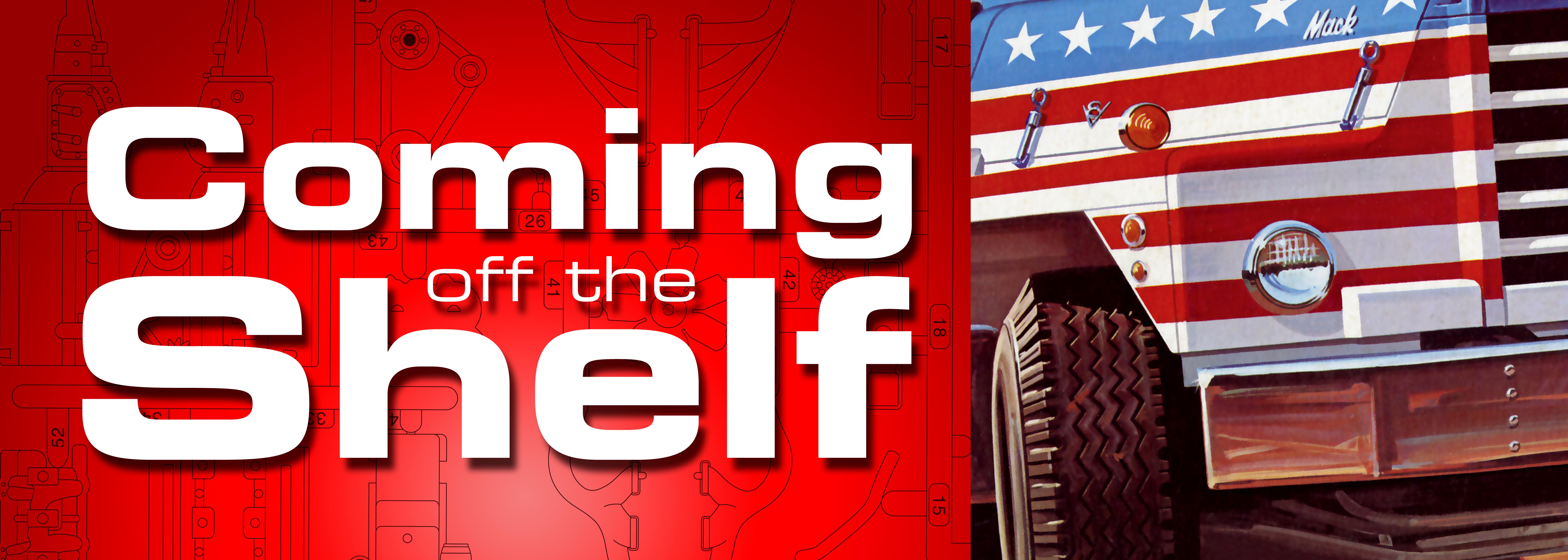
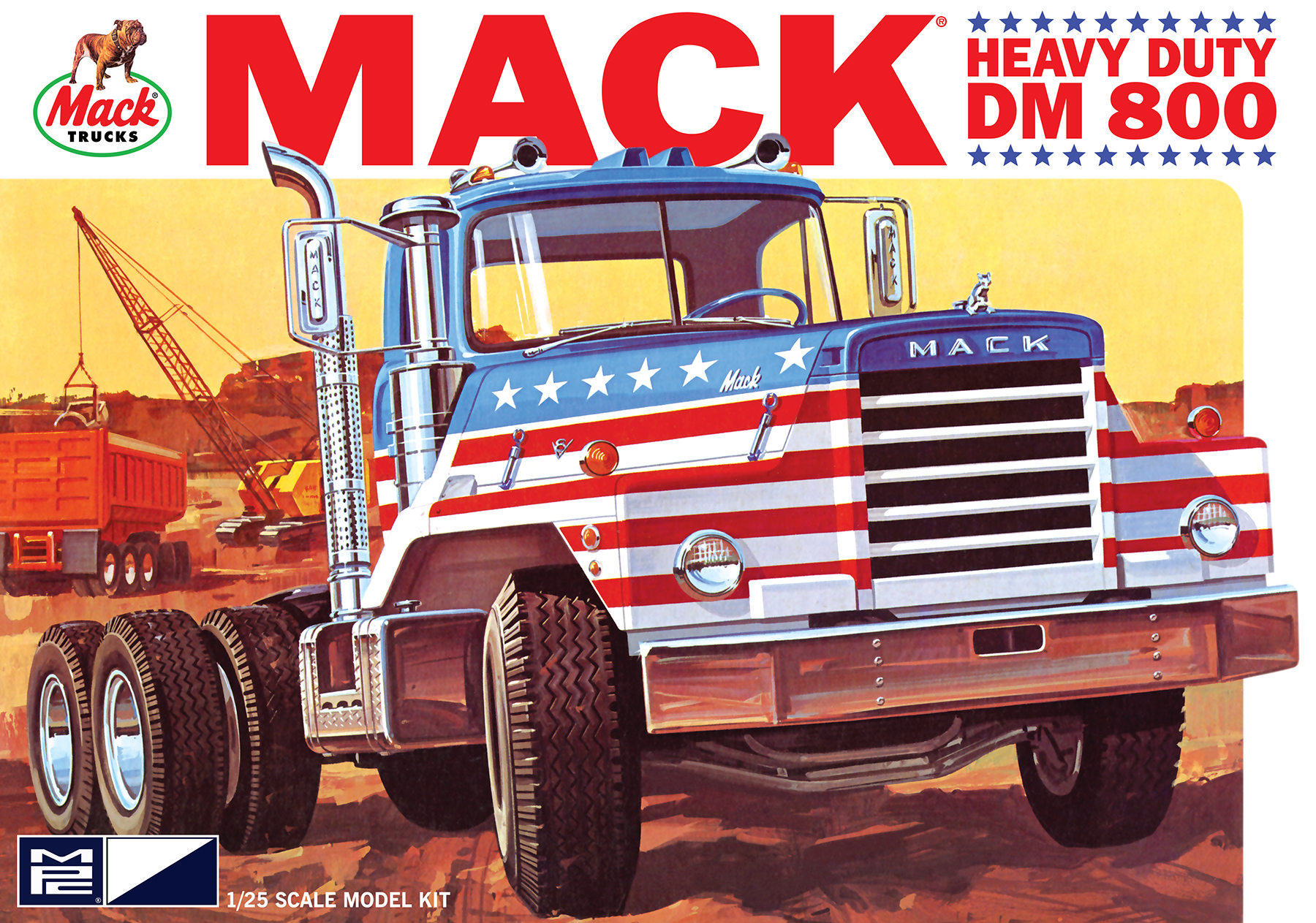
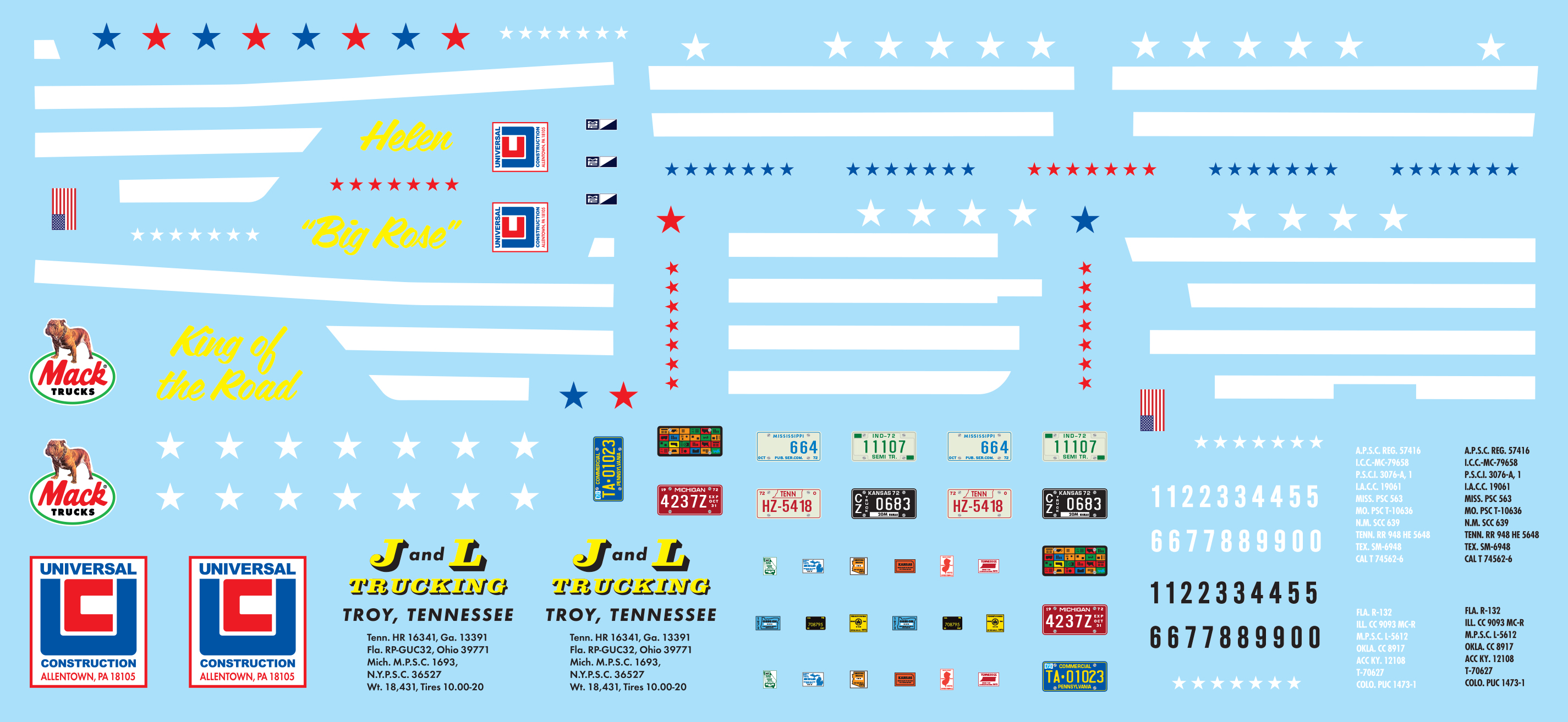
As we’re headed into the heat of summer the folks at MPC are proud to offer, for the first time in quite a while, the “King” of brawny highway haulers. The Mack DM800! Packed with big rig quality—like a detailed interior with air conditioning, the turbo-charged 865 Maxidyne engine, two extensive chrome trees, a fully functional butterfly hood, and a steerable front end, the heavy duty Mack DM800 is worth the build. And if that is not enough, we’ve also expanded the decal sheet, so you can add even more detail to your build, and taken the packaging back to its original glory.
So get ready Mack builders, cause the DM800 is just around the bend! Available soon at many of your local hobby dealers or online.
Star Trek Models: Klingon Bird-of-Prey & U.S.S. Grissom
[UPDATED to show decal sheet]
In the midst of summer activities and staying at work on our new Klingon K’t’inga kit, we don’t want to overlook another exciting Polar Lights kit we have in the works – the Klingon Bird-of-Prey and U.S.S. Grissom 1/1000 scale snap-together kit. These are two fan-favorite ships and the Grissom is getting produced as a kit for the first time ever thanks to the numerous requests we’ve heard over the years. These two kits make a fine addition to our line or 1:1000 scale snap kits.
Here is a look at the packaging which features box lid artwork by Star Trek Production Artist, John Eaves. The box utilizes the updated Star Trek style guide and as has become our habit, we show a full color decoration guide on the sides of the box bottom. Both models come with stands and the Bird-of-Prey can be assembled with its wings up in cruising position or down in attack position.
After some delays in the tooling and test fit phase the kit is in production now, and product should arrive around the end of August.
Polar Lights Models: Klingon K’t’inga test shots are coming!
It is great to see all of the attention our new Star Trek: the Motion Picture 1:350 scale Klingon K’t’tinga model is getting. Folks have been oohing and ahhing over the photos of the new mockup we showed off at Wonderfest. Test shots are shipping and they should arrive by the weekend. I just wanted to share a small teaser and fill you in on what we’ll be sharing in the next couple weeks.
Jim Small is our go-to buildup guy. He is a consultant on virtually every sci-fi kit we put out. As usual, I am super-busy and Jim is willing to share his progress on the test shots and buildup as he works on it. So we will be posting his progress here and simultaneously (give or take a few minutes) on his Small Art Works Facebook page. He’ll get more in depth with it than I would be able to do anyway.
I might pop in to show photos of my test build. I also hope to squeeze in some time to discuss the color research we’ve done on the ship and share some of that… and maybe even get some help or feedback on finding some specific paint colors to match. More on that soon (hopefully).
But now… more of these…
And some of this! (from our friends at the factory) It is getting real, folks!
Round 2 Models: Wonderfest USA 2018 and K’t’inga update
We had a wonderful time at Wonderfest USA last weekend. It is always great to see everyone and see the reaction to our new kits and news. Rather than posting a bunch of pics here and linking this post to our Facebook page, I’m going to do the opposite. I’ve posted two albums there. One of the show in general and the other specific to the K’t’inga. (click the colored underlined words to go to look at the pics)
Our biggest “NEWS” announcement of the show was that we have obtained the license to STAR TREK DISCOVERY. We realize opinions are very mixed on the show and the ship designs, but we feel that there needs to be product in the market for those for whom this will be their introduction to Star Trek. Our first kit will be a 1:2500 scale U.S.S. Discovery which will measure just short of 12″ long. It will include a few clear parts which is a feature our other 1:2500 scale kits lack. We were polling attendees to get feedback on what to do next.
- Which larger kit size would you prefer? 1:1000 OR 1:1400 (look at the poster to see the difference)
- After the 1:2500 scale U.S.S. Discovery, which would you rather see next? 1:1000/ 1:1400 U.S.S. Discovery OR 1:2500 U.S.S. Shenzhou and U.S.S. Enterprise (essentially, in 2019 we can either do a big Discovery next OR do the other two ships in the same scale as our first Discovery kit)
- Which ship design do you prefer? U.S.S. Shenzhou OR U.S.S Enterprise (Both have merit, but which should we do first?)
This seems to have caused no small amount of confusion with some people online interpreting this as us doing all three ships in all three scales. Oh well. these things happen these days. Here is a closer look at our board. Feel free to let us know your thoughts by leaving a comment.
KAT CHAT: Totally Tubular Tires!
Hello Automotive Modeling Enthusiasts,
Here’s a quick “snap Kat” photo showing the beautiful gold lettered and pinstriped Firestone tires that are included with the upcoming Tiger Shark reintroduction – in big and little sizes! Also shown is the upcoming AMTPP020/24 “Wild Wheels & Wide Ovals” parts pack which includes four sweet white lettered Firestone Wide Oval tires and four “street is neat” five-spoke mags!
Grab the glue, it’s all for you! COMING SOON
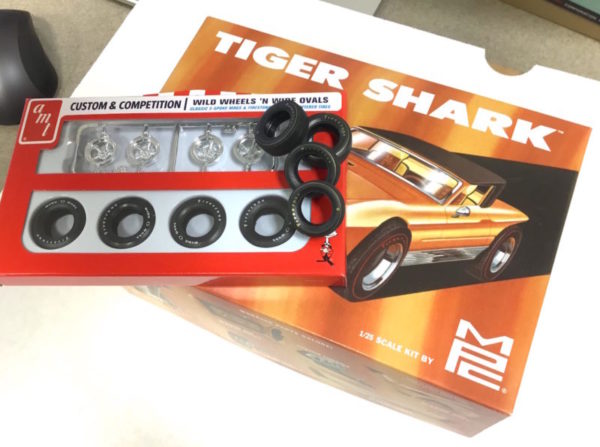
Polar Lights Models: More K’t’inga goodness
It has been a great week. Thank you for such an overwhelmingly positive reaction to our K’t’inga kit announcement. We knew Star Trek modelers everywhere would love it, because you’ve made it perfectly clear how badly you wanted it. But still, the reaction was better than we could have predicted. A set of test shots for another kit did not show up this week as expected, so we’ll share some more images and info on the K’t’inga kit.
First, let’s answer some questions.
How long is the model? – In our excitement last week, we neglected to mention the length of the model. It will be 24″ long and nearly 18″ wide. Some have suggested that seems small, but the length was based on existing information that was widely accepted. Could one debate that it should be longer? Sure, but in process of developing a kit of this stature, weight has to be given to tooling space and the cost that incurs. So, it comes down to A) we can make an argument that at 1:350 scale the ship would be 24″ long and B) we can afford to tool up a 24″ long K’t’inga. We can’t afford to do a bigger one. If you disagree with the scale, you can call it what you want. No hard feelings.
Yay! Now when can we expect a 1:350 D-7, Reliant, 1:1000 Enterprise-D or 1:32 Galileo? – Your guess is as good as ours. Our history speaks for itself. So, don’t expect them soon. But, let’s consider this… what would there be interest a Galileo without a full interior? Deleting the interior would make it an affordable option at some point. No promises one way or another, but feel free to offer feedback on that notion.
It looks like the white parts in the mockup represent the clear parts in the kit. Is that how you plan to address the windows on the bulb? – For the most part, the unpainted resin parts in the mockup represent parts that are to be included as clear parts in the kit. However, part of the purpose of doing a prototype is to see what you think will work actually works in practice. After seeing the cobra head windows knocked out, we are considering knocking windows out in the bulb. Those windows will be tiny. A clear backer will be included, but if you want those portholes to filled to present a flush face window, we will be suggesting liquid window maker to fill them.
Is the hull plating symmetrical? – On the kit yes, on the filming miniature not so much. It mostly was, but not 100%. We are going to KISS it. (Keep It Simple Stupid)
What will prevent neck sagging? – Good engineering. The mockup had no locators whatsoever. We will be sure we have accounted for the possibility of the neck to sag or break at the bulkhead. It is a lot like the pylon issue on the 1:350 TOS kit. We know well enough to figure it out.
Will ALL the detail be maintained? – Yes and no. The work in the mockup had not fully taken into account tool drafting. In some spots details might be compromised, or we will break parts up a bit differently to get as much detail as we can. In some instances we aren’t satisfied with the result and we’ll see if the factory can find a way to do better. I predict we will be able to maintain about 95% of the detail by the time it is done.
The photos below will show some “behind the scenes” shots of the mockup in various states of assembly. They should provide a decent sense of scale. It also gives a preview of how the light kit will look. A thin coat of primer wasn’t enough to hide the light, but we needed to install as much as we could to be sure we had enough light where we needed it and adjust as needed.
Lastly, you’ll see an image with yellow arrows pointing to some parts on the filming miniature. As most people realize, many of these details were pulled from plastic model kits available during production of the film. Our consultant team identified nearly all of the “greeblies” that were used. This is the most noticeable piece one has evaded our attempts to identify the kit (or thing) it originally comes from. If you know, please let us know. We used the limited reference we have to draw up the part. If we can make it more accurate, we would like to.

